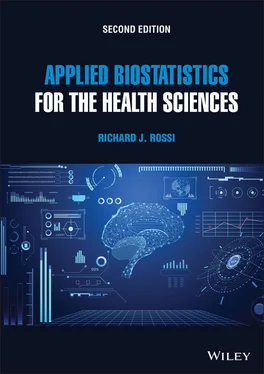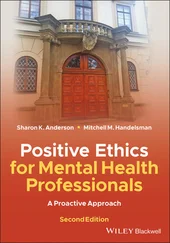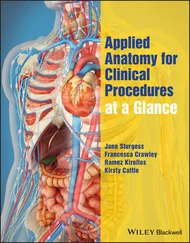Richard J. Rossi - Applied Biostatistics for the Health Sciences
Здесь есть возможность читать онлайн «Richard J. Rossi - Applied Biostatistics for the Health Sciences» — ознакомительный отрывок электронной книги совершенно бесплатно, а после прочтения отрывка купить полную версию. В некоторых случаях можно слушать аудио, скачать через торрент в формате fb2 и присутствует краткое содержание. Жанр: unrecognised, на английском языке. Описание произведения, (предисловие) а так же отзывы посетителей доступны на портале библиотеки ЛибКат.
- Название:Applied Biostatistics for the Health Sciences
- Автор:
- Жанр:
- Год:неизвестен
- ISBN:нет данных
- Рейтинг книги:3 / 5. Голосов: 1
-
Избранное:Добавить в избранное
- Отзывы:
-
Ваша оценка:
- 60
- 1
- 2
- 3
- 4
- 5
Applied Biostatistics for the Health Sciences: краткое содержание, описание и аннотация
Предлагаем к чтению аннотацию, описание, краткое содержание или предисловие (зависит от того, что написал сам автор книги «Applied Biostatistics for the Health Sciences»). Если вы не нашли необходимую информацию о книге — напишите в комментариях, мы постараемся отыскать её.
APPLIED BIOSTATISTICS FOR THE HEALTH SCIENCES Applied Biostatistics for the Health Sciences
Applied Biostatistics for the Health Sciences
Applied Biostatistics for the Health Sciences — читать онлайн ознакомительный отрывок
Ниже представлен текст книги, разбитый по страницам. Система сохранения места последней прочитанной страницы, позволяет с удобством читать онлайн бесплатно книгу «Applied Biostatistics for the Health Sciences», без необходимости каждый раз заново искать на чём Вы остановились. Поставьте закладку, и сможете в любой момент перейти на страницу, на которой закончили чтение.
Интервал:
Закладка:
512 497
513 498
514 499
515 500
516 501
517 502
518 503
519 504
520 505
521 506
522 507
523 508
524 509
525 510
526 511
527 512
528 513
529 514
530 515
531 516
532 517
533 518
534 519
535 520
536 521
537 522
538 523
539 524
540 525
541 526
542 527
543 528
544 529
545 530
546 531
547 532
548 533
549 534
550 535
551 536
552 537
553 538
554 539
555 540
556 541
557 542
558 543
559 544
560 545
561 546
562 547
563 548
564 549
565 550
566 551
567 552
568 553
569 554
570 555
571 556
572 557
573 558
574 559
575 560
576 561
577 562
578 563
579 564
580 565
581 566
582 567
583 568
584 569
585 570
586 571
587 572
588 573
589 574
590 575
591 576
592 577
593 578
594 579
595 580
596 581
597 582
598 583
599 584
600 585
601 586
602 587
603 588
604 589
605 590
606 591
607 592
608 593
609 594
610 595
611 596
612 597
613 598
614 599
615 600
616 601
617 602
618 603
619 604
620 605
621 606
622 607
623 608
624 609
625 610
626 611
627 612
628 613
629 614
630 615
631 616
632 617
633 618
634 619
635 620
636 621
637 622
638 623
639 624
640 625
641 626
642 627
643 628
644 629
645 630
646 631
647 632
648 633
649 634
650 635
651 636
652 637
653 638
654 639
655 640
656 641
657 642
658 643
659 644
660 645
661 646
662 647
663 648
664 649
665 650
666 651
667 652
668 653
669 654
670 655
671 656
672 657
673 658
674 659
675 660
676 661
677 662
678 663
679 664
680 665
681 666
682 667
PREFACE
Applied Biostatistics for the Health Sciences is intended for use in an introductory biostatistics class for undergraduates in the health sciences including students studying premedicine, nursing, pharmacy, bioinformatics, healthcare informatics, biochemistry, and applied health sciences. This textbook is also appropriate for a first course in statistics for medical students or graduate students in public health. In fact, this book was written for introducing students to biostatistics as well as for preparing students for the material covered in upper division applied statistics courses. The only prerequisite for a course taught from this textbook is a typical course in high school algebra II or college algebra.
Topic Coverage
The topics chosen for this book were chosen for pedagogical reasons and have been tried, tested, and adjusted over the past 40 years of teaching introductory courses in statistics. Throughout Applied Biostatistics for the Health Sciences , the primary emphasis is placed on the correct usage, interpretation, and the conceptual ideas associated with each biostatistical method that is discussed.
The textbook is organized in two parts with Chapters 1– 7covering the basic inferential biostatistical methods used to describe sample data arising in a biomedical or health-related study. Chapters 8– 13cover several modeling approaches that are commonly used with biomedical and healthcare data. In particular, the following topics are presented in this textbook.
Chapter 1: Introduction to Biostatistics. Chapter 1provides an introduction to the ideas and basic terminology of biostatistics as well as the commonly used research protocols. Experiments are contrasted with observational studies and clinical trials are also discussed in Chapter 1. A description of the data sets used in several of the examples and exercises is given at the end of Chapter 1.
Chapter 2: Describing Populations. Chapter 2introduces variables, populations, population parameters, probability, and the binomial and normal probability models. Several biomedical parameters are introduced in Chapter 2including the prevalence of a disease, the specificity and sensitivity of a diagnostic test, and the relative risk associated with a disease and risk factor.
Chapter 3: Random Sampling. The basic ideas associated with random sampling are discussed in Chapter 3. In particular, the simple random sampling, stratified random sampling, random cluster sampling, and systematic random sampling plans are discussed including the determination of the appropriate sample size for estimating a mean or proportion with a prespecified bound on the error of estimation. The formulas for determining the overall sample size and its allocation for a stratified random sample may be considered as an optional topic and covered as time permits.
Chapter 4: Summarizing Random Samples. Several important graphical and numerical summary statistics for qualitative and quantitative variables are presented. In particular, along with the standard point estimators of the measures of location and dispersion, point estimators for estimating the prevalence of a disease, the sensitivity and specificity of a diagnostic test, the relative risk, and the coefficient of variation are presented in Chapter 4. The plug-in rule for estimating parameters is also included in this chapter.
Chapter 5: Measuring the Reliability of Statistics. The sampling distribution of an estimator is discussed in Chapter 5with emphasis on evaluating the reliability of a point estimator. The topics discussed in Chapter 5include properties of point estimators including the bias, standard error, bound on the error of estimation, and mean squared error associated with a point estimator. The Central Limit Theorem for the sample proportion and sample mean, the t distribution, and bootstrapping the sampling distribution of a point estimator are discussed in this chapter. The section on bootstrapping can be considered optional material to be covered if time permits.
Chapter 6: Confidence Intervals. Confidence intervals for a single proportion, a single mean, the difference of two proportions, the difference of two means, and the relative risk are presented in Chapter 6. Formulas for determining the sample size required for a prespecified margin of error are included for estimating a proportion, mean, and the difference between two proportions. Bootstrap confidence intervals are also discussed in this chapter and can be considered optional material.
Chapter 7: Testing Statistical Hypotheses. Chapter 7includes a general discussion of hypothesis testing and significance testing that is followed by the hypothesis tests for testing hypotheses about a single proportion, t tests for a single mean, paired t-tests, and the two-sample t-test. Formulas for determining the approximate sample size required for a test having a prespecified size and power are also presented for each testing procedure.
Chapter 8: Simple Linear Regression. Chapter 8is the first chapter in a series of chapters on modeling a response variable. The topics covered in Chapter 8include analyzing scatterplots, correlation, the simple linear regression model, fitting and assessing the fit of a simple linear regression model, and statistical inferences drawn from a fitted model.
Chapter 9: Multiple Regression. Chapter 9extends and broadens the methods discussed in Chapter 8to multiple regression models. The multiple regression topics that are discussed in Chapter 9include linear and nonlinear models, fitting and assessing the fit of a multiple regression model, drawing inferences from a fitted model, comparing nested regression models, dummy variable models, and variable selection procedures.
Читать дальшеИнтервал:
Закладка:
Похожие книги на «Applied Biostatistics for the Health Sciences»
Представляем Вашему вниманию похожие книги на «Applied Biostatistics for the Health Sciences» списком для выбора. Мы отобрали схожую по названию и смыслу литературу в надежде предоставить читателям больше вариантов отыскать новые, интересные, ещё непрочитанные произведения.
Обсуждение, отзывы о книге «Applied Biostatistics for the Health Sciences» и просто собственные мнения читателей. Оставьте ваши комментарии, напишите, что Вы думаете о произведении, его смысле или главных героях. Укажите что конкретно понравилось, а что нет, и почему Вы так считаете.












